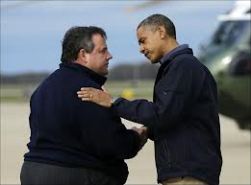 Chris Christie hasn’t even been elected to a second-term as governor of New Jersey and the media can’t stop talking about the possibility of his candidacy for president in 2016.
Chris Christie hasn’t even been elected to a second-term as governor of New Jersey and the media can’t stop talking about the possibility of his candidacy for president in 2016.
In September and October, three main topics about Chris Christie as a politician have emerged from the media. Both Politico and the New York Times have referenced his role in the recovery of Hurricane Sandy, his ability to work with both Republicans and Democrats, and his vocal opinions about the recent shutdown. Analyzing ten news stories, five from the New York Times and five from Politico, multiple trends have become apparent. In five stories from Politico, Christie’s potential 2016 presidential bid was mentioned eight times, whereas in five New York Times stories, the 2016 race was mentioned twice. The New York Times stories have raised questions on Christie’s stance on gay marriage, his effectiveness in the Hurricane Sandy recovery, and his actual fiscal record as governor of New Jersey. It is interesting to note that three of the New York Times pieces landed on the front page. Scrutiny of his record as governor of New Jersey may be valid if we consider his current campaign for re-election. In the possibility of a presidential candidacy, Christie’s position as a Northeastern Republican needs additional appeal to the Republican conservative base. As he emphasizes continued “fiscal sanity” in New Jersey, the New York Times questions how accurate Christie’s declarations are. This scrutiny seems to exist in coverage as he is running for re-election, however, as it is the national edition of the New York Times, to what extent may this recent front page scrutiny be considered agenda-setting?
Politico has focused on political relationships and Christie’s vocal opinions on issues such as the government shutdown and Hurricane Sandy. In a recent story recounting the one-year anniversary of the devastating storm, Politico recounted Christie’s interaction with President Obama. Christie is quoted referring to his interaction with President Obama after the storm, “He and I spoke every day for at least the next 10 days – every day – sometimes more than once a day and it was substantive conversations.” Politico has used examples such as this to frame Christie as an individual less concerned with party politics allowing him to gain increased bipartisan support. Each of these five Politico articles have framed Christie as a politician focused on tackling problems and his ability to work with both Republicans and Democrats. Two articles have highlighted polls, which indicate his support among African-American voters, and a recent endorsement by Shaquille O’Neal in the New Jersey gubernatorial race which have contributed to Christie’s commanding lead against state senator Barbara Buono.
It is clear that the Politico stories have used positive tone to their coverage of Chris Christie, while The New York Times has used a more negative tone. If agenda setting exists in this form of coverage of Chris Christie, is it responsible for the media to report in this way? How will coverage like this influence public opinion on Chris Christie in the upcoming gubernatorial election? In Christie’s possible presidential candidacy? Effect on politicians in general?








